6.1.1: Where Do Igneous Rocks Occur?
- Page ID
- 18723
| Silica (SiO2) Content of Some Common Igneous Rocks | |||
| 45-55 wt% | 55-65 wt% | >65 wt% | |
| volcanic rock | basalt | andesite | rhyolite |
| plutonic rock | gabbro | diorite | granite |
All igneous rocks are made of the same major elements, but elemental ratios vary. The most significant variations are the amounts of silica (SiO2) present (see table). Most igneous rocks contain between 45 and 70 wt% silica. They range from lower-silica basalt and gabbro to higher-silica rhyolite and granite. Other elemental concentrations vary systematically, too. For example, basalt and gabbro contain more iron and magnesium than andesite and diorite, and andesite and diorite contain more iron and magnesium than rhyolite and granite. Other compositional variations are less profound or regular.
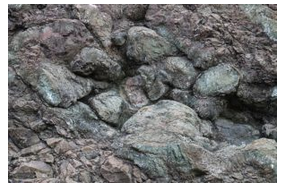
Extrusive igneous rocks are found worldwide, and individual varieties are not restricted to a single tectonic setting. Basalt is the most abundant igneous rock in Earth’s crust. The oceans cover two-thirds of Earth, and basalt forms at mid-ocean ridges to become the main component of the uppermost oceanic crust. Ocean basalt typically is found in 1/2-km-thick layers that may or may not be covered by sediments. These basalts sometimes form as pillow basalts, like the basalt seen in this photo (Figure 6.7). The pillow structure develops as the basalt is extruded into cold ocean water. Lesser amounts of basalt are found at subduction zones where, in association with andesites, rhyolites, and related rocks, basalts may be part of composite volcanos.
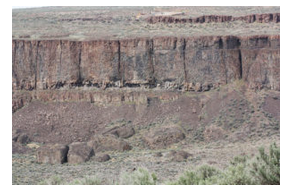
In continental interiors, hot spots and rifts can produce large volumes of basalt flows, in some places creating huge flood basalt provinces such as the Columbia River Flood Basalts of Idaho, Washington, and Oregon. Lava flows may be thick; the basalt cliff in the photo in Figure 6.8 is about 150 m tall. Because all basalts have similar compositions, they generally contain the same minerals, most importantly plagioclase and pyroxene. Often they contain small or large amounts of volcanic glass as well.
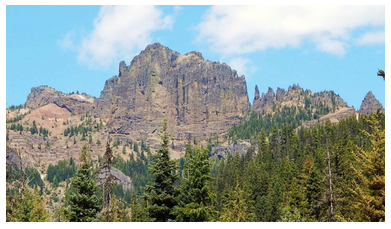
volumes of andesite, the most common volcanic rock after basalt, are found with dacite and rhyolite in island arcs and at continental margin subduction zones. The photo in Figure 6.9 shows subduction-related andesite at Fifes Peaks in western Washington. Less commonly, andesite is associated with continental rifts or hot spots. Even more rarely, andesite is found at mid-ocean ridges. Andesite is always rich in plagioclase, and may contain biotite, pyroxene, or hornblende. Quartz and olivine are rare. Rhyolite, always containing quartz and K-feldspar, occurs in the same settings as basalt and andesite but is only common in continental areas. Rhyolites are especially abundant at hot spots such as the Yellowstone Hotspot in northwest Wyoming. They are also associated with continental rifts such as the Rio Grande Rift in southern Colorado and New Mexico, and at subduction zones.
Plutonic igneous rocks, too, occur in many diverse settings. Granites, granodiorites, and related rocks collectively called granitoids, are found worldwide and are major components of the continental crust. They are especially common in Precambrian shields and younger mountain belts, where they form intrusions of all sizes, from small dikes and plutons to large batholiths.
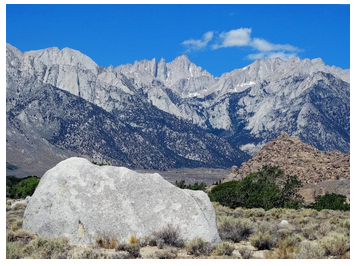
and surrounding peaks near Lone Pine, California. The exposed
rock is part of the Sierra Nevada Batholith.
Batholiths (masses of intrusive rock composed of multiple plutons) form the cores of many mountain ranges. The Sierra Nevada Batholith in California and Nevada, for example, is a mostly granitic mass that crops out, or is just beneath the surface, in a 650 km long region that is 100 to 125 km wide. Figure 6.10 shows rocks exposed at Mt. Whitney, California. Mt. Whitney is part of the the Sierra Nevada Batholith. Overall, the mineralogy of the Sierra Nevada Batholith is mostly quartz, plagioclase, and potassium feldspar with lesser amounts of biotite and hornblende. Although typically found in shields and mountain belts, batholiths and other granitic rocks are also associated with rifts, spreading centers, and hot spots.

The photo in Figure 6.11 shows a cross section of the Sierra Nevada Batholith exposed in the vertical face of El Capitan in Yosemite Valley, California. Look closely at the photo and you can see that there are several different colored rock types. Most are white or salmon colored granite; the darker patches are diorite.
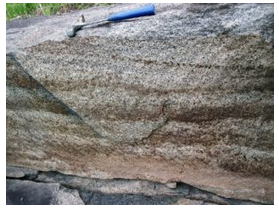
Plutonic rocks span a wide range of compositions. Those that contain less silica than granite, including for example gabbro (equivalent in composition to the most common volcanic rock, basalt), also form plutons of all sizes. They do not, however, form large batholiths. Large volumes of gabbro make up the lower part of oceanic crust. Lesser amounts are found in layered intrusions or associated with continental hot spots and rifts. The Duluth Complex, west and north of Lake Superior, is one of the largest known gabbroic occurrences. The complex is a 16-km thick sill, composed mostly of gabbro with lesser amounts of anorthosite and granitic rocks. The gabbro seen in Figure 6.12, from an outcrop in Duluth, Minnesota, consists of light-colored plagioclase and darker pyroxene.


